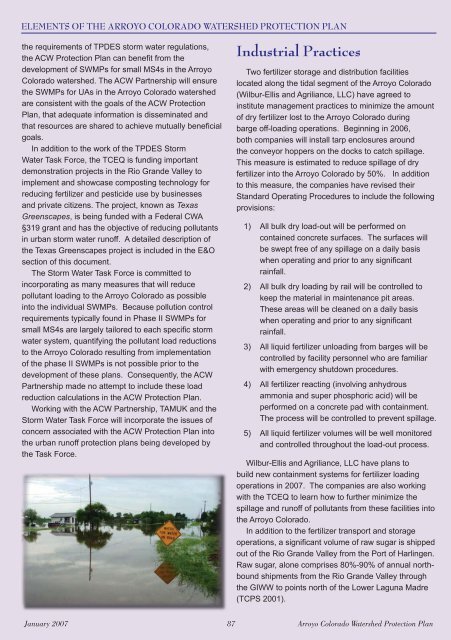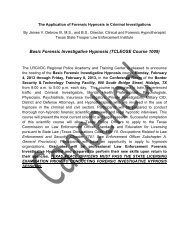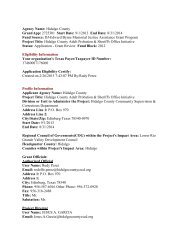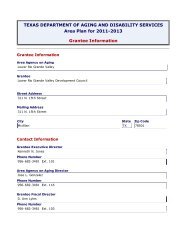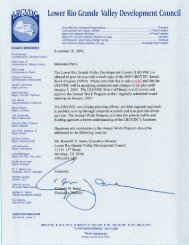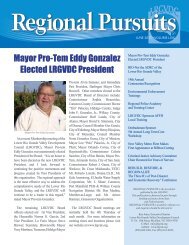Watershed Protection Plan - Lower Rio Grande Valley Development ...
Watershed Protection Plan - Lower Rio Grande Valley Development ...
Watershed Protection Plan - Lower Rio Grande Valley Development ...
Create successful ePaper yourself
Turn your PDF publications into a flip-book with our unique Google optimized e-Paper software.
ELEMENTS OF THE ARROYO COLORADO WATERSHED PROTECTION PLAN<br />
the requirements of TPDES storm water regulations,<br />
the ACW <strong>Protection</strong> <strong>Plan</strong> can benefi t from the<br />
development of SWMPs for small MS4s in the Arroyo<br />
Colorado watershed. The ACW Partnership will ensure<br />
the SWMPs for UAs in the Arroyo Colorado watershed<br />
are consistent with the goals of the ACW <strong>Protection</strong><br />
<strong>Plan</strong>, that adequate information is disseminated and<br />
that resources are shared to achieve mutually benefi cial<br />
goals.<br />
In addition to the work of the TPDES Storm<br />
Water Task Force, the TCEQ is funding important<br />
demonstration projects in the <strong>Rio</strong> <strong>Grande</strong> <strong>Valley</strong> to<br />
implement and showcase composting technology for<br />
reducing fertilizer and pesticide use by businesses<br />
and private citizens. The project, known as Texas<br />
Greenscapes, is being funded with a Federal CWA<br />
§319 grant and has the objective of reducing pollutants<br />
in urban storm water runoff. A detailed description of<br />
the Texas Greenscapes project is included in the E&O<br />
section of this document.<br />
The Storm Water Task Force is committed to<br />
incorporating as many measures that will reduce<br />
pollutant loading to the Arroyo Colorado as possible<br />
into the individual SWMPs. Because pollution control<br />
requirements typically found in Phase II SWMPs for<br />
small MS4s are largely tailored to each specifi c storm<br />
water system, quantifying the pollutant load reductions<br />
to the Arroyo Colorado resulting from implementation<br />
of the phase II SWMPs is not possible prior to the<br />
development of these plans. Consequently, the ACW<br />
Partnership made no attempt to include these load<br />
reduction calculations in the ACW <strong>Protection</strong> <strong>Plan</strong>.<br />
Working with the ACW Partnership, TAMUK and the<br />
Storm Water Task Force will incorporate the issues of<br />
concern associated with the ACW <strong>Protection</strong> <strong>Plan</strong> into<br />
the urban runoff protection plans being developed by<br />
the Task Force.<br />
Industrial Practices<br />
Two fertilizer storage and distribution facilities<br />
located along the tidal segment of the Arroyo Colorado<br />
(Wilbur-Ellis and Agriliance, LLC) have agreed to<br />
institute management practices to minimize the amount<br />
of dry fertilizer lost to the Arroyo Colorado during<br />
barge off-loading operations. Beginning in 2006,<br />
both companies will install tarp enclosures around<br />
the conveyor hoppers on the docks to catch spillage.<br />
This measure is estimated to reduce spillage of dry<br />
fertilizer into the Arroyo Colorado by 50%. In addition<br />
to this measure, the companies have revised their<br />
Standard Operating Procedures to include the following<br />
provisions:<br />
1) All bulk dry load-out will be performed on<br />
contained concrete surfaces. The surfaces will<br />
be swept free of any spillage on a daily basis<br />
when operating and prior to any signifi cant<br />
rainfall.<br />
2) All bulk dry loading by rail will be controlled to<br />
keep the material in maintenance pit areas.<br />
These areas will be cleaned on a daily basis<br />
when operating and prior to any signifi cant<br />
rainfall.<br />
3) All liquid fertilizer unloading from barges will be<br />
controlled by facility personnel who are familiar<br />
with emergency shutdown procedures.<br />
4) All fertilizer reacting (involving anhydrous<br />
ammonia and super phosphoric acid) will be<br />
performed on a concrete pad with containment.<br />
The process will be controlled to prevent spillage.<br />
5) All liquid fertilizer volumes will be well monitored<br />
and controlled throughout the load-out process.<br />
Wilbur-Ellis and Agriliance, LLC have plans to<br />
build new containment systems for fertilizer loading<br />
operations in 2007. The companies are also working<br />
with the TCEQ to learn how to further minimize the<br />
spillage and runoff of pollutants from these facilities into<br />
the Arroyo Colorado.<br />
In addition to the fertilizer transport and storage<br />
operations, a signifi cant volume of raw sugar is shipped<br />
out of the <strong>Rio</strong> <strong>Grande</strong> <strong>Valley</strong> from the Port of Harlingen.<br />
Raw sugar, alone comprises 80%-90% of annual northbound<br />
shipments from the <strong>Rio</strong> <strong>Grande</strong> <strong>Valley</strong> through<br />
the GIWW to points north of the <strong>Lower</strong> Laguna Madre<br />
(TCPS 2001).<br />
January 2007 87 Arroyo Colorado <strong>Watershed</strong> <strong>Protection</strong> <strong>Plan</strong>


